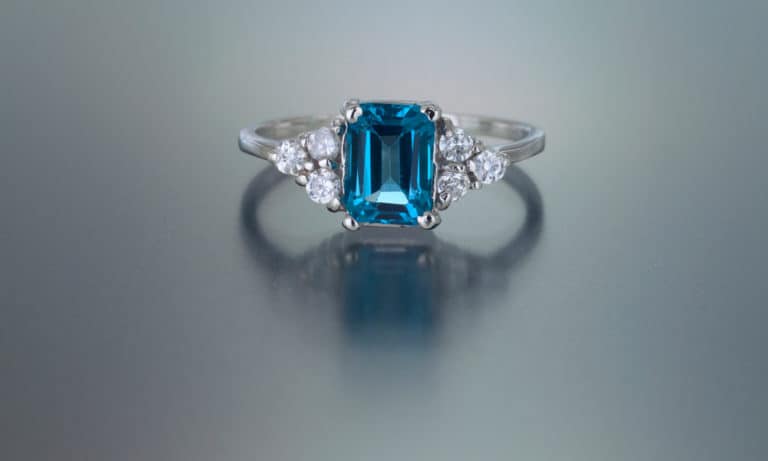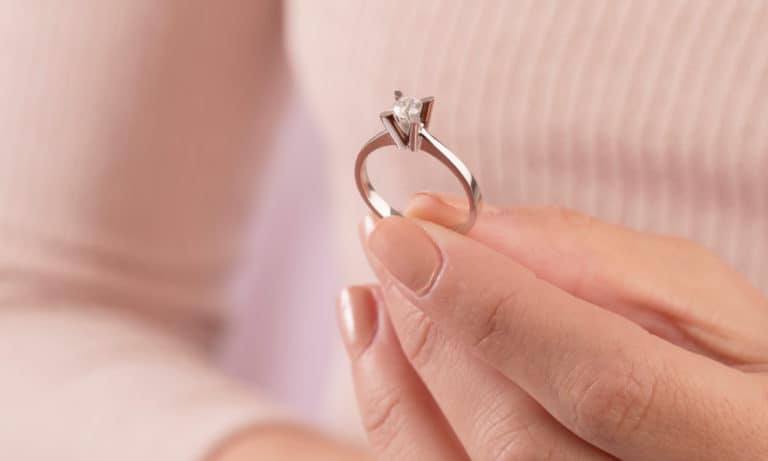
Are you looking for a stone that looks exactly like a diamond but doesn’t cost as much? Well, you found one.
A diamond simulant is as close as it gets to the real thing. It looks just like a natural diamond, although it has different physical properties and chemical structures.
Still, a simulated diamond can look beautiful regardless of the jewelry piece you’re interested in. Continue reading to learn more about the stone and what makes it a good purchase.
What is a Diamond Simulant

A diamond simulant is often referred to as a simulated diamond, imitation diamond, diamond imitation, and diamond alternative. It has similar geological characteristics to those of an actual diamond.
These are meant to imitate the look of a real diamond. They can be both natural and synthetic, but don’t confuse them with lab-created synthetic diamonds.
Natural simulants include quartz, topaz, and zircon, while synthetics simulants include rhinestone, moissanite, cubic zirconia, rutile, and spinel.
Simulant vs. Synthetic Diamond
It’s not a rare thing for people to refer to synthetic and simulant diamonds as the same. However, they’re not the same.
A diamond simulant is made in the lab to mimic the look and appearance of a real diamond. It can be made from a wide variety of materials, but it doesn’t have the same chemical composition the real diamond has.
Synthetic diamonds are not simulants, although both are created in a lab. Synthetics are man-made with the same chemical composition and crystal structure as natural diamonds.
A synthetic diamond looks like the real thing, and it even has the same hardness. The only difference between real and synthetic diamonds is where they come from.
With that said, you can easily understand the differences and why synthetic stones aren’t to be confused with simulants.
https://www.youtube.com/watch?v=9a2dMwBvEi4
How is it different
You might not be able to tell a diamond simulant by just looking at it. These are carefully made to look just the same, so it’s hard to spot the difference unless you’re trained.
But, there are ways. First of all, you should buy from a reputable seller who will disclose a diamond it simulant.
Now, let’s look at similarities and differences that can help you tell if a diamond is a simulant.
- Color– most simulants are made colorless, which makes it hard to tell that you’re not looking at a real diamond. A well-done simulant could receive the highest grade if you were to grade it on the diamond color scale.
- Clarity– diamond simulants are perfect. In fact, they’re too perfect. They don’t have any internal flaws since created artificially. Natural diamonds have inclusions you won’t see in a diamond simulant.
- Hardness – diamonds are the hardest materials that can only be scratched by another diamond. A simulant diamond isn’t nearly as hard and durable. It will scratch, crack, and chip more easily.
- Setting– a simulant diamond is almost always found in a cheaper setting. You’re unlikely to find it set in platinum. Instead, these are usually mounted in silver or gold-plated metal.
- Sparkle – when lit, simulants have much more colorful sparkle. This might not always be the case, but it can help tell apart the cubic zirconia and similar simulants.
- Price – price is possibly the clearest indication that what you have is a diamond simulant. Real diamonds are expensive, and simulants sell for a fraction of that price. If someone offers you a beautiful diamond for a low price, it’s most likely not real.
- Electrical and Thermal Conductivity –a diamond simulant doesn’t have the same chemical structure as the real one. This means it also has different electrical and thermal conductivity.
- Fluorescence – fluorescence is the ability of a diamond to emit light and change color in the sun. The colors that appear are usually yellow, blue, green, red, and mauve. Simulant diamonds show identical light as opposed to a wider spectrum.
Popular Diamond Simulants

Diamond simulants are actually quite popular due to their appearance. However, it’s important to note that many types vary in quality, appearance, and composition.
Some are made from natural minerals, while others are completely synthetic. Here are the most common ones:
- Topaz– topaz is among the most popular diamond simulants. It’s made from fluorine and aluminum, so it’s pretty hard. However, it contains prismatic crystals, which causes it to have less shine.
- Quartz – this one is often called Herkimer or rock crystal diamond. It comes in a wide range of colors, but it’s almost always slightly cloudy. Also, this is a naturally occurring mineral.
- Crystal or leaded glass – glass diamonds are man-made but beautiful and glossy. They’re easy to break and chip.
- Scheelite– scheelite isn’t as popular as other simulants. It can be natural or synthetic, but it’s often flawed with small clouds, lines, or bubbles.
- Beryl– is a natural gemstone that comes in many colors. It can be transparent white, resembling a real diamond, but it often has flaws and impurities that damage the shine and depth.
- White zircon– white zircon is similar to cubic zirconia, but it has a different crystal structure. It comes in many colors.
- Sphalerite– sphalerite isn’t as commonly used because it’s very fragile and soft. However, it has a high shine and looks beautiful in the light.
- Cubic zirconia– cubic zirconia is quite possibly the most popular diamond simulant. It’s among the finest options, but it’s less durable and likely to discolor after a while.
- Lab-created – these are entirely synthetic, offering shine and clarity but without ethical or financial costs.
Advantages and Drawbacks
Diamond simulants have many advantages and can be a good choice for a ring stone. Still, you’ll see them used in other jewelry, thanks to their many qualities.
Still, much like any other stone, a diamond simulant has drawbacks. For these stones, the issue is usually in the durability since many of them are somewhat brittle.
Do you need help making up your mind? These pros and cons can help you.
Pros:
- Lab-Made– diamond simulants are made in labs, so they’re carefully curated to perfection. You can find many different diamond simulants made from various materials.
- Easy to Clean– these are typically easy to clean with soapy water, so you won’t have to get your stone professionally cleaned. Many can be cleaned using steam or ultrasonic cleaning procedures.
- Eco-friendly– did you know that mining diamonds causes a wreck to the environment? Even some ethically mined stones aren’t, in fact, friendly to landscapes and animals. A diamond simulant is created in a lab, meaning that no mining takes place. This makes it eco-friendly.
- Conflict-free– the mining industry often involves poor working conditions, child labor, and human rights violation. Simulants are created in labs that don’t contribute to the problems typically associated with the mining industry. A lab-created diamond is easy to track back to where it came from.
- Affordable –a diamond simulant often costs up to 80% less than the real thing. This makes it a perfect affordable option if you’re on a budget. You still get brilliance and shine, but for a much lower price.
Cons:
- Durability– the biggest concern with diamond simulants is their durability. Still, it often depends on the particular stone you go for since some are more brittle than others. Also, simulants are relatively easy to scratch, whereas real diamonds are far more resistant and durable.
- Reflective Index– simulated diamonds don’t shine and reflect light the same way as real diamonds. Again, it depends on the particular stone you go for. For example, moissanite has a higher index than a real diamond, giving off the “disco-ball” effect with its overbearing shine. Cubic zirconia has a lower index than real diamonds and often gives off a “rainbow effect”.
Should You Buy a Diamond Simulant
The simple answer is – why not? Diamond simulants are cheaper than real diamonds, which allows you to go bigger when choosing a stone for your jewelry.
As mentioned, they have many advantages and are ideal if you’re on a budget. Plus, there are many stones to pick from depending on the particular piece of jeweler you’re creating.
Still, you should know exactly what you’re buying. In some cases, it’s easy to tell that a diamond isn’t real, but in others, you’d need professional equipment.
Whether or not you should buy it for an engagement ring, it’s up to you. Simulants aren’t as durable, which can be a concern since you’ll probably wear your engagement ring every day and for a long time.
Weigh the pros and cons to figure out whether a simulant is a good choice for your jewelry.
Conclusion
A diamond simulant is lab-made, so it’s also eco-friendly and conflict-free. It’s affordable and can work great for any jewelry you’re interested in as long as you’re aware that it’s a simulant.
It requires proper care, but it’s generally easy to maintain with just soapy water.
In this article, we also talked about:
- Popular simulants
- Pros and cons
- How to identify it
- Should you buy it
Which diamond simulant appeals to you the most? Do you think they’re easy to tell apart from real diamonds? Let us know in the comments what do you think about these stones.






